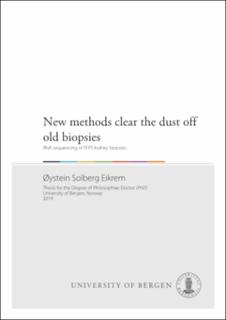| dc.contributor.author | Eikrem, Øystein Solberg | en_US |
| dc.date.accessioned | 2019-09-13T09:04:05Z | |
| dc.date.available | 2019-09-13T09:04:05Z | |
| dc.date.issued | 2019-06-07 | |
| dc.identifier.isbn | 978-82-308-3000-0 | en_US |
| dc.identifier.uri | https://hdl.handle.net/1956/20831 | |
| dc.description.abstract | Background and aims: Formalin-fixed, paraffin-embedded (FFPE) tissues are an underused resource for molecular analyses. We wanted to exploit renal biopsies also on the mRNA level to elucidate pathophysiological mechanisms and to ultimately define novel therapies of kidney diseases. The work in this thesis aimed to assess the technical feasibility of RNA sequencing per se and the quality of the respective mRNA data derived from extracted RNA of whole FFPE tissue sections. In the first paper the main aim was to test whether lower quality, partially degraded RNA obtained from archival formalin-fixed and paraffin-embedded (FFPE) renal tissues could serve as appropriate source of material for RNA sequencing. This was approached by testing transcriptome sequencing of RNA from concurrently harvested FFPE and fresh stored kidney biopsies. In the second paper we aimed to validate and expand the first analysis by investigating a second cohort of FFPE kidney biopsies from local ccRCC patients. The secondary aim of this thesis was to assess the technical feasibility and the quality of mRNA data obtained from LCM renal tissues. Further, the aim of the third paper was to evaluate the most appropriate method to extract RNA from FFPE renal tissues and to compare yield and quality of extracted RNA between the different methods with the target of conducting RNA sequencing, especially from LCM glomerular cross-sections. Methods: Kidney biopsies from resected tissues belonging to patients undergoing nephrectomy were obtained with a 16g core biopsy needle. In paper I, tumor samples and adjacent normal tissue specimens were FFPE or RNAlater® stored. In paper II, only FFPE kidney biopsies were used. In the third paper, FFPE biopsies from rat and human tissues were utilized. In all papers RNA sequencing libraries were built with the newly released Illumina’s TruSeq® Access library preparation kit (recently renamed RNA exome kit). Comparative analyses were done using voom/Limma package in R. Main results: In the first paper we demonstrated that the FFPE and RNAlater® datasets gave comparable numbers of detected genes, differentially expressed transcripts and affected pathways. The average expression and the differentially expressed genes had very high correlation between the FFPE and RNAlater® stored samples. In paper I and II the detected genes relevant for ccRCC were in accordance with the current literature. The number of detected transcripts in the “discovery/paper I” and “confirmation/paper II” data set gave 8957 and 11,047 detected transcripts, respectively. These data sets shared 1193 of differentially expressed genes. The average expression and the differentially expressed transcripts in both data sets correlated, with R2 of 0,95 and R2 of 0,94, respectively. In the third paper, several kits were eligible for RNA extraction from FFPE tissues from both whole kidney biopsy sections and from LCM samples. Conclusions: Gene expression data obtained from FFPE kidney biopsies are comparable to data obtained from freshly stored material, thus expanding the utility of archival tissue specimens. Next-generation sequencing expands the clinical application of tissue analyses from FFPE biopsies and gives results well in line with the current literature. RNA can be extracted from archival renal biopsies in sufficient quality and quantity from a single human kidney biopsy section and from around 100 LCM glomerular cross-sections to enable successful RNA library preparation and sequencing using commercially available RNA extraction kits. | en_US |
| dc.language.iso | eng | eng |
| dc.publisher | The University of Bergen | eng |
| dc.relation.haspart | Paper I: Transcriptome Sequencing (RNAseq) Enables Utilization of Formalin-Fixed, Paraffin-Embedded Biopsies with Clear Cell Renal Cell Carcinoma for Exploration of Disease Biology and Biomarker Development. Eikrem O, Beisland C, Hjelle K, Flatberg A, Scherer A, Landolt L, Skogstrand T, Leh S, Beisvag V, Marti HP (2016) PLoS ONE 11(2): e0149743. The article is available at: <a href="http://hdl.handle.net/1956/15632" target="blank">http://hdl.handle.net/1956/15632</a> | en_US |
| dc.relation.haspart | Paper II: Development and confirmation of potential gene classifiers of human clear cell renal cell carcinoma using next-generation RNA sequencing. Eikrem O, Strauss P, Beisland C, Scherer A, Landolt L, Flatberg A, Leh S, Beisvag V, Skogstrand T, Hjelle K, Shresta A, Marti HP (2016) Scandinavian Journal of Urology, 50:6, 452-462. Full text not available in BORA due to publisher restrictions. The article is available at: <a href="https://doi.org/10.1080/21681805.2016.1238007" target="blank">https://doi.org/10.1080/21681805.2016.1238007</a> | en_US |
| dc.relation.haspart | Paper III: RNA extraction for RNA sequencing of archival renal tissues. Landolt L, Marti HP, Beisland C, Flatberg A, Eikrem O (2016) Scandinavian Journal of Clinical and Laboratory Investigation, 76:5, 426-434. Full text not available in BORA due to publisher restrictions. The article is available at: <a href="https://doi.org/10.1080/00365513.2016.1177660" target="blank">https://doi.org/10.1080/00365513.2016.1177660</a> | en_US |
| dc.title | New methods clear the dust off old biopsies. RNA sequencing of FFPE kidney biopsies | en_US |
| dc.type | Doctoral thesis | |
| dc.rights.holder | Copyright the author. All rights reserved | |
| dc.identifier.cristin | 1703516 | |
